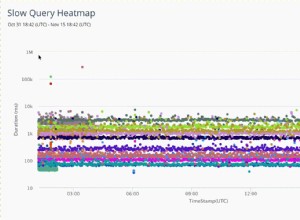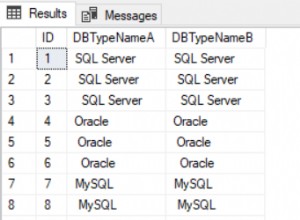Hai solo bisogno di un database helper per tutte le tabelle in un database e quindi useresti quello onCreate metodo per la creazione delle tabelle. Notando che se si dispone di più assistenti di database che onCreate (e suAggiorna metodo) verrebbe chiamato solo una volta dal primo helper che ha aperto il database e quindi, oltre ad avere più helper inefficienti, potrebbe essere più complicato avere più database helper.
Più precisamente onCreate viene chiamato automaticamente solo quando il database non esiste. Per il momento onCreate è chiamato il database stesso è stato creato.
suAggiorna viene chiamato solo quando all'apertura del database il numero di versione passato alla chiamata (tramite la super call) è maggiore del numero di versione memorizzato nel file di database. Il numero di versione memorizzato nel file, in questo momento, viene quindi aggiornato per riflettere la versione più recente. Pertanto le chiamate successive non invocheranno onUpgrade metodo.
Indipendentemente dal fatto che tu divida o meno i metodi e gli identificatori, come i nomi delle colonne/tabelle per le singole tabelle, è una scelta che potresti fare. Alcuni potrebbero considerare scomodo dividere altri potrebbero pensare che sia più chiaro.
Esempio
Il codice seguente è un esempio di 3 permutazioni (e anche database) che utilizzano tutte 2 tabelle, ovvero table001 (colonne _id e i miei dati ) e table001 (nomi delle colonne _id e altri dati personali ).
-
utilizza un singolo databaseHelper (DBHelper001) con tutto incorporato nell'helper. Il database è mydb001
-
utilizza un unico databasehelper (DBHelper002) con i metodi e le costanti specifici della tabella in classi specifiche orientate alla tabella (classe Table001 e classe Table002).
-
utilizza due database helper separati (DBHelperTable001 e DBHelperTable002) e per semplicità di codice utilizza le classi Table001 e Table002.
- Tieni presente che per superare onCreate essere chiamato solo una volta onOpen il metodo tenta anche di creare la rispettiva tabella (
CREATE TABLE IF NOT EXISTS ......essere importante in questo caso per evitare un errore quando la tabella esiste effettivamente). - Nota che questa è solo una delle inefficienze di avere più assistenti.
- Tieni presente che per superare onCreate essere chiamato solo una volta onOpen il metodo tenta anche di creare la rispettiva tabella (
Prima le classi specifiche della tabella (non utilizzate dalla prima permutazione)
Tabella001.java
public class Table001 {
public static final String TBL_TABLE001 = "table001";
public static final String COL_TABLE001_ID = BaseColumns._ID;
public static final String COL_TABLE001_MYDATA = "mydata";
public static String getCrtSQL() {
return "CREATE TABLE IF NOT EXISTS " + TBL_TABLE001 + "(" +
COL_TABLE001_ID + " INTEGER PRIMARY KEY, " +
COL_TABLE001_MYDATA + " TEXT" +
")";
}
public static long insert(SQLiteDatabase db, String mydata) {
ContentValues cv = new ContentValues();
cv.put(COL_TABLE001_MYDATA,mydata);
return db.insert(TBL_TABLE001,null,cv);
}
public static Cursor getAll(SQLiteDatabase db) {
return db.query(TBL_TABLE001,null,null,null,null,null,null);
}
}
Tabella002.java
public class Table002 {
public static final String TBL_TABLE002 = "table002";
public static final String COL_TABLE002_ID = BaseColumns._ID;
public static final String COL_TABLE002_MYOTHERDATA = "myotherdata";
public static String getCrtSQL() {
return "CREATE TABLE IF NOT EXISTS " + TBL_TABLE002 + "(" +
COL_TABLE002_ID + " INTEGER PRIMARY KEY, " +
COL_TABLE002_MYOTHERDATA + " TEXT" +
")";
}
public static long insert(SQLiteDatabase db, String mydata) {
ContentValues cv = new ContentValues();
cv.put(COL_TABLE002_MYOTHERDATA,mydata);
return db.insert(TBL_TABLE002,null,cv);
}
public static Cursor getAll(SQLiteDatabase db) {
return db.query(TBL_TABLE002,null,null,null,null,null,null);
}
}
Le quattro classi di supporto del database
DBHelper001.java - (autonomo)
public class DBHelper001 extends SQLiteOpenHelper {
public static final String DBNAME = "mydb001";
public static final int DBVERSION = 1;
public static final String TBL_TABLE001 = "table001";
public static final String TBL_TABLE002 = "table002";
public static final String COL_TABLE001_ID = BaseColumns._ID;
public static final String COL_TABLE001_MYDATA = "mydata";
public static final String COL_TABLE002_ID = BaseColumns._ID;
public static final String COL_TABLE002_MYOTHERDATA = "myotherdata";
public DBHelper001(Context context) {
super(context, DBNAME, null, DBVERSION);
}
@Override
public void onCreate(SQLiteDatabase db) {
String crt_table001_sql = "CREATE TABLE IF NOT EXISTS " + TBL_TABLE001 + "(" +
COL_TABLE001_ID + " INTEGER PRIMARY KEY," +
COL_TABLE001_MYDATA + " TEXT" +
")";
String crt_table002_sql = "CREATE TABLE IF NOT EXISTS " + TBL_TABLE002 + "(" +
COL_TABLE002_ID + " INTEGER PRIMARY KEY," +
COL_TABLE002_MYOTHERDATA + " TEXT" +
")";
db.execSQL(crt_table001_sql);
db.execSQL(crt_table002_sql);
}
@Override
public void onUpgrade(SQLiteDatabase db, int oldVersion, int newVersion) {
}
public long insertIntoTable001(String mydata) {
SQLiteDatabase db = this.getWritableDatabase();
ContentValues cv = new ContentValues();
cv.put(COL_TABLE001_MYDATA,mydata);
return db.insert(TBL_TABLE001,null,cv);
}
public long insertIntoTable002(String myotherdata) {
SQLiteDatabase db = this.getWritableDatabase();
ContentValues cv = new ContentValues();
cv.put(COL_TABLE002_MYOTHERDATA,myotherdata);
return db.insert(TBL_TABLE002,null,cv);
}
public Cursor getAllFromTable001() {
SQLiteDatabase db = this.getWritableDatabase();
return db.query(TBL_TABLE001,null,null,null,null,null,null);
}
public Cursor getAllFromTable002() {
SQLiteDatabase db = this.getWritableDatabase();
return db.query(TBL_TABLE002,null,null,null,null,null,null);
}
}
DBHelper002.java (codice specifico della tabella altrove)
public class DBHelper002 extends SQLiteOpenHelper {
public static final String DBNAME = "mydb002";
public static final int DBVERSION = 1;
public DBHelper002(Context context) {
super(context, DBNAME, null, DBVERSION);
}
@Override
public void onCreate(SQLiteDatabase db) {
db.execSQL(Table001.getCrtSQL());
db.execSQL(Table002.getCrtSQL());
}
@Override
public void onUpgrade(SQLiteDatabase db, int oldVersion, int newVersion) {
}
}
DBHelperTable001.java (helper specifico per table001)
public class DBHelperTable001 extends SQLiteOpenHelper {
public static final String DBNAME = "mydb003";
public static final int DBVERSION = 1;
public DBHelperTable001(Context context) {
super(context, DBNAME, null, DBVERSION);
}
@Override
public void onCreate(SQLiteDatabase db) {
db.execSQL(Table001.getCrtSQL());
//NOTE Table002 won't get created as onCreate is only called once
}
@Override
public void onUpgrade(SQLiteDatabase db, int oldVersion, int newVersion) {
}
@Override
public void onOpen(SQLiteDatabase db) {
super.onOpen(db);
db.execSQL(Table001.getCrtSQL());
}
}
- Nota il onOpen viene utilizzato per evitare che onCreate venga invocato solo una volta per tutta la durata del database.
- il richiamo di execSQL è un esempio di inefficienza di questa metodologia.
DBHelperTable002.java (helper specifico per table002)
public class DBHelperTable002 extends SQLiteOpenHelper {
public static final String DBNAME = "mydb003";
public static final int DBVERSION = 1;
public DBHelperTable002(Context context) {
super(context, DBNAME, null, DBVERSION);
}
@Override
public void onCreate(SQLiteDatabase db) {
db.execSQL(Table002.getCrtSQL());
//NOTE Table001 won't get created as onCreate is only called once
}
@Override
public void onUpgrade(SQLiteDatabase db, int oldVersion, int newVersion) {
}
@Override
public void onOpen(SQLiteDatabase db) {
super.onOpen(db);
db.execSQL(Table002.getCrtSQL());
}
}
Legandoli tutti insieme
La seguente attività utilizza (MainActivity.java ) utilizza tutte e 3 le permutazioni. Per ciascuno viene aggiunta una riga a ciascuna tabella e quindi tutti i dati di ciascuna tabella vengono estratti in un cursore che viene quindi scaricato (output nel registro).
Nota che per gli helper specifici della tabella ogni helper viene utilizzato per estrarre le righe (mostrando l'aspetto della ridondanza).
MainActivity.java
public class MainActivity extends AppCompatActivity {
DBHelper001 mDBHlpr1;
DBHelper002 mDBHlpr2;
DBHelperTable001 mTblDBHlpr1;
DBHelperTable002 mTblDBHlpr2;
Cursor mCsr;
@Override
protected void onCreate(Bundle savedInstanceState) {
super.onCreate(savedInstanceState);
setContentView(R.layout.activity_main);
mDBHlpr1 = new DBHelper001(this);
mDBHlpr1.insertIntoTable001("my data for table001 in mydb001");
mDBHlpr1.insertIntoTable002("my other data for table002 in mydb001");
mCsr = mDBHlpr1.getAllFromTable001();
DatabaseUtils.dumpCursor(mCsr);
mCsr = mDBHlpr1.getAllFromTable002();
DatabaseUtils.dumpCursor(mCsr);
mDBHlpr2 = new DBHelper002(this);
Table001.insert(mDBHlpr2.getWritableDatabase(),"my data for table001 in mydb002");
Table002.insert(mDBHlpr2.getWritableDatabase(),"my other data for table002 in mydb002");
mCsr = Table001.getAll(mDBHlpr2.getWritableDatabase());
DatabaseUtils.dumpCursor(mCsr);
mCsr = Table002.getAll(mDBHlpr2.getWritableDatabase());
DatabaseUtils.dumpCursor(mCsr);
//Oooops???? wouldn't normally do this
mCsr = Table001.getAll(mDBHlpr1.getWritableDatabase()); //?????????? from other database!!!
DatabaseUtils.dumpCursor(mCsr);
mTblDBHlpr1 = new DBHelperTable001(this);
Table001.insert(mTblDBHlpr1.getWritableDatabase(),"my data for table001 in mydb003");
mTblDBHlpr2 = new DBHelperTable002(this);
Table002.insert(mTblDBHlpr2.getWritableDatabase(),"my data for table002 in mydb003");
mCsr = Table001.getAll(mTblDBHlpr1.getWritableDatabase());
DatabaseUtils.dumpCursor(mCsr);
mCsr = Table002.getAll(mTblDBHlpr1.getWritableDatabase()); //???????????? but OK
DatabaseUtils.dumpCursor(mCsr);
mCsr = Table001.getAll(mTblDBHlpr2.getWritableDatabase());
DatabaseUtils.dumpCursor(mCsr);
mCsr = Table002.getAll(mTblDBHlpr2.getWritableDatabase()); //??????????? but OK
DatabaseUtils.dumpCursor(mCsr);
}
}
Risultato
Quello che segue è il risultato della prima esecuzione (nota che l'esecuzione più volte senza disinstallare l'app comporterà l'aggiunta di 2 nuove righe):-
03-06 11:27:18.453 11093-11093/? I/System.out: >>>>> Dumping cursor [email protected] 03-06 11:27:18.453 11093-11093/? I/System.out: 0 { 03-06 11:27:18.453 11093-11093/? I/System.out: _id=1 03-06 11:27:18.453 11093-11093/? I/System.out: mydata=my data for table001 in mydb001 03-06 11:27:18.453 11093-11093/? I/System.out: } 03-06 11:27:18.453 11093-11093/? I/System.out: <<<<< 03-06 11:27:18.453 11093-11093/? I/System.out: >>>>> Dumping cursor [email protected] 03-06 11:27:18.453 11093-11093/? I/System.out: 0 { 03-06 11:27:18.453 11093-11093/? I/System.out: _id=1 03-06 11:27:18.453 11093-11093/? I/System.out: myotherdata=my other data for table002 in mydb001 03-06 11:27:18.453 11093-11093/? I/System.out: } 03-06 11:27:18.453 11093-11093/? I/System.out: <<<<< 03-06 11:27:18.472 11093-11093/? I/System.out: >>>>> Dumping cursor [email protected] 03-06 11:27:18.472 11093-11093/? I/System.out: 0 { 03-06 11:27:18.472 11093-11093/? I/System.out: _id=1 03-06 11:27:18.472 11093-11093/? I/System.out: mydata=my data for table001 in mydb002 03-06 11:27:18.472 11093-11093/? I/System.out: } 03-06 11:27:18.472 11093-11093/? I/System.out: <<<<< 03-06 11:27:18.472 11093-11093/? I/System.out: >>>>> Dumping cursor [email protected] 03-06 11:27:18.473 11093-11093/? I/System.out: 0 { 03-06 11:27:18.473 11093-11093/? I/System.out: _id=1 03-06 11:27:18.473 11093-11093/? I/System.out: myotherdata=my other data for table002 in mydb002 03-06 11:27:18.473 11093-11093/? I/System.out: } 03-06 11:27:18.473 11093-11093/? I/System.out: <<<<< 03-06 11:27:18.473 11093-11093/? I/System.out: >>>>> Dumping cursor [email protected] 03-06 11:27:18.473 11093-11093/? I/System.out: 0 { 03-06 11:27:18.473 11093-11093/? I/System.out: _id=1 03-06 11:27:18.473 11093-11093/? I/System.out: mydata=my data for table001 in mydb001 03-06 11:27:18.473 11093-11093/? I/System.out: } 03-06 11:27:18.473 11093-11093/? I/System.out: <<<<< 03-06 11:27:18.499 11093-11093/? I/System.out: >>>>> Dumping cursor [email protected] 03-06 11:27:18.500 11093-11093/? I/System.out: 0 { 03-06 11:27:18.500 11093-11093/? I/System.out: _id=1 03-06 11:27:18.500 11093-11093/? I/System.out: mydata=my data for table001 in mydb003 03-06 11:27:18.500 11093-11093/? I/System.out: } 03-06 11:27:18.500 11093-11093/? I/System.out: <<<<< 03-06 11:27:18.500 11093-11093/? I/System.out: >>>>> Dumping cursor [email protected] 03-06 11:27:18.500 11093-11093/? I/System.out: 0 { 03-06 11:27:18.501 11093-11093/? I/System.out: _id=1 03-06 11:27:18.501 11093-11093/? I/System.out: myotherdata=my data for table002 in mydb003 03-06 11:27:18.501 11093-11093/? I/System.out: } 03-06 11:27:18.501 11093-11093/? I/System.out: <<<<< 03-06 11:27:18.501 11093-11093/? I/System.out: >>>>> Dumping cursor [email protected] 03-06 11:27:18.501 11093-11093/? I/System.out: 0 { 03-06 11:27:18.501 11093-11093/? I/System.out: _id=1 03-06 11:27:18.501 11093-11093/? I/System.out: mydata=my data for table001 in mydb003 03-06 11:27:18.501 11093-11093/? I/System.out: } 03-06 11:27:18.502 11093-11093/? I/System.out: <<<<< 03-06 11:27:18.502 11093-11093/? I/System.out: >>>>> Dumping cursor [email protected] 03-06 11:27:18.502 11093-11093/? I/System.out: 0 { 03-06 11:27:18.502 11093-11093/? I/System.out: _id=1 03-06 11:27:18.502 11093-11093/? I/System.out: myotherdata=my data for table002 in mydb003 03-06 11:27:18.503 11093-11093/? I/System.out: } 03-06 11:27:18.503 11093-11093/? I/System.out: <<<<<




